 Young, wild, and free—of conscience, worries, and inhibitions. 
Celebrities on paperback fronts are a (yet another) weakness of ours. We've been seduced into reading books by cover imagery from the likes of Kitty Swan, Elke Sommer, and Christina Lindberg, among others. Greenleaf Classics put Spanish star Soledad Miranda on the cover of Alan Marshall's 1974 novel Wild Young Flesh. The shot is a variation of an image of Miranda we shared years back. You may remember she died young in an automobile accident in 1970 at age twenty-seven, but left behind a few interesting movies, such as El diablo que vinó de Akasawa and 100 Rifles. And now, this cover.
Alan Marshall was a pseudonym, and while it was sometimes used by known authors such as Donald Westlake, in this case the actual writer remains unknown. The story deals with the carnal goings-on among a group of high schoolers. In addition to it being a creepy experience reading its explicit underaged sex, about a quarter of the story takes place in a utility closet. If you know anything about sleaze novels and the talent level involved, the fact that the author couldn't be bothered to set scenes outside of a single small room tells you that the narrative is extremely minimal. But we couldn't resist Soledad. We'll just try to put this one behind us, though, and we recommend that you don't put it in front of you.
 He's hopelessly outclassed by his prey. And the tiger is a problem too. 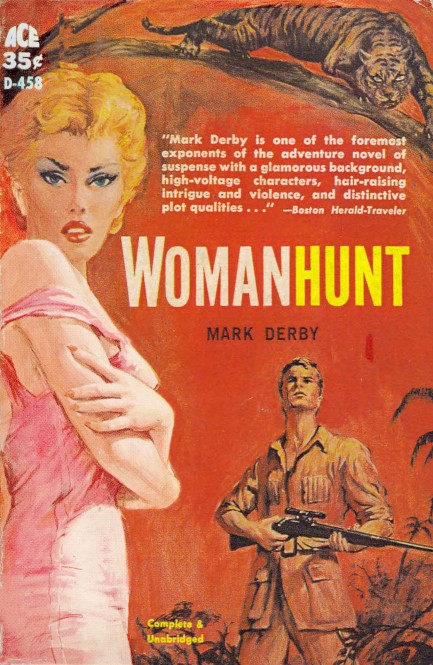
Above you see a nice cover by an uncredited illustrator for 1959's Womanhunt, written by Harry Wilcox posing as his alter ego Mark Derby and published in this Ace paperback edition in 1960. This is interesting visual work. You notice that the femme fatale's eyes resemble the tiger's eyes. That comparison is at the crux of the tale Derby tells. In the story a government agent named Dickson (Dix to his friends) is sent upcountry in Malaya to pose as a big game hunter there to kill a deadly tigress, while behind the scenes he's searching out a communist cabal and determining whether an agent already there is doing her job or has turned.
That agent—Anna Swansey—is someone Dix barely knows but is “miserably and hopelessly in love with.” Under the pressure of his mission, his feelings turn into a consuming obsession. As high concept novels go, the idea of trying to stalk an apex predator, arouse love within a woman, and expose a spy ring all at once is as ripe as it gets. There's a lot going on at all times, and Derby keeps multiple plates spinning on sticks while treating readers to some nice passages, like this one:
Before her magnificent body, an electric apparition of charcoal, gold, and white, had passed out of sight, he had a second view of her snarl, the haughty sneer that drew mouth and white whiskers high and quivering on each side, the narrowing of the usually rounded eyes, the flash of the ivory teeth.
At one point Dix is alone in the jungle and hears the tigress's roar. It's a moment when he realizes, terrifyingly, that his hunt of her may have turned into her hunt of him:
He jumped as if a cannon had gone off. He had got it into his head that she was somewhere over on his right, or behind him, and this growl came from directly ahead. It sounded awesomely near, too. [snip] The roar, a sound which perhaps only one in every million human beings ever hears, and only one in ten million ever hears at close quarters, filled the dark jungle with shock. There was a moment, perhaps of one second, during which Dix did nothing but stiffen; then his arms moved and the beam of the flashlight mounted on the rifle barrel cut a cone of light in the dark clearing.
The title of book registers weird in 2024, but it isn't misogynist—or not very. A few web pages say the woman of the hunt is, metaphorically, the tigress. No. It's a metaphor, alright, but not one that simple. The woman of the hunt is actually both the tigress and Anna. That's made clear because Derby flogs the woman-as-tigress metaphor until it's welted from nose to tail. But he's also capable of smirking at it, briefly anyway, such as here:
“My grandfather used to say that a tigress was a woman, a woman who did not wish to be caught. She would hide down trails the hunter didn’t know and, just like a woman, her lies would be more clever than his traps. That’s what he used to say.” ’Che Kadan was fond of quoting his grandfather, who’d been one of the Malayan sultans—an old man of character, it seemed, since his quoted remarks were invariably mere clichés or sentimental platitudes which must have been remembered for the authority with which he’d uttered them.
It's a comparison that's probably insulting to most modern women, but don't let it fool you. The tale is steeped in debilitating male emotion, lustful obsession, existential terror, and a desperate loneliness. It reads tragically at times, as Dix tries but fails to keep Anna from slowly taking over his thoughts. And that's another unusual aspect of the book: Dix is increasingly driven by jealousy. At first it's directed only against Anna's boss Charlton Lang, who also wants her badly and uses his authority to constantly keep her near him in a work capacity. Then Anna's ex-lover shows up. Dix is driven near to madness by this event.
Derby deals in high emotion. For example, big cats generally kill humans when they're the only obtainable prey. Usually the animal is hurt, or very old. Dix sympathizes with the tigress, doesn't consider her to be in any way at fault, but people keep getting eaten, so he has no choice about killing her—not merely as matter of his cover, but as a matter of saving lives. His conflict over this is wrenching, symbolic of terrible choices forced on us all. To add an extra ingredient, he isn't an experienced hunter. He can shoot—but he isn't expert. His pursuit of the tigress is ridiculously dangerous.
This is a great book. However, the usual warnings apply to colonial fiction. In addition, within the communist plotlines Dix's quarries are all fools, monsters, or victims of coercion. Capitalism wasn't then—and isn't now—turning the world into a fruit laden banquet table overflowing with goodness for all, and Derby was surely smart enough to understand that. But despite the billions killed to establish and maintain his preferred global order, he never touches the reasons why alternative political philosophies take hold. In his mind, resistance comes from the deluded, from dolts who—for inexplicable reasons—believe colonials have no right to steal foreign lands. That may annoy the more politically objective readers.
But while more character depth on that front would have made Womanhunt perfect, and its total and rather smug one-sidedness means it has to be partly classified as propaganda, Derby can really construct and deliver an adventure. How do you wrap up a communist spy caper, Malayan big game hunt, and heart-hurting love story all at once? Those spinning plates never wobble. The hunt's spectacular end flows immediately into the climax of the spy tale, and within that chaotic resolution the love story concludes with fireworks. We'll be revisiting Derby soon. 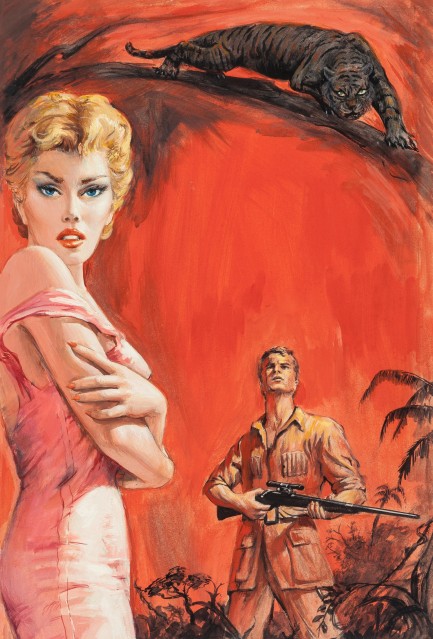
 I see. So we'd be like good cop-bad cop, except one of us has sex with them and the other murders them. Can I be the good cop?
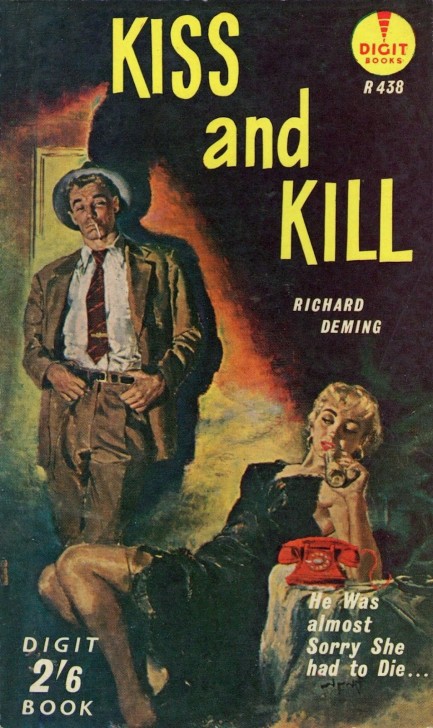
Charles Binger, whose work we don't see often enough, created this great cover for Richard Deming's 1960 novel Kiss and Kill. The book is about a couple of grifters who graduate from bunco scams to serial murders, first luring lonely women into marriage before offing them for their money. The two then skedaddle to other parts, rinse, and repeat. They never get too greedy in choosing their victims, as that would draw attention. They garner maybe $10,000 profit per murder. Actually, at one point they score $67,000, which would last normal people in 1960 half a lifetime, but they lose most of the money in Monte Carlo. Their fatal flaw—other than being murderers—is that they like to live high, so cash goes fast, which means they generally need to kill every three or four months. This goes on for five years, from Los Angeles to Miami Beach and points between, before complications arise. The main complication? Love. This is our second Deming, and our second success with him.

 I'm happy for you both—but you're putting excruciating pressure on my catheter. 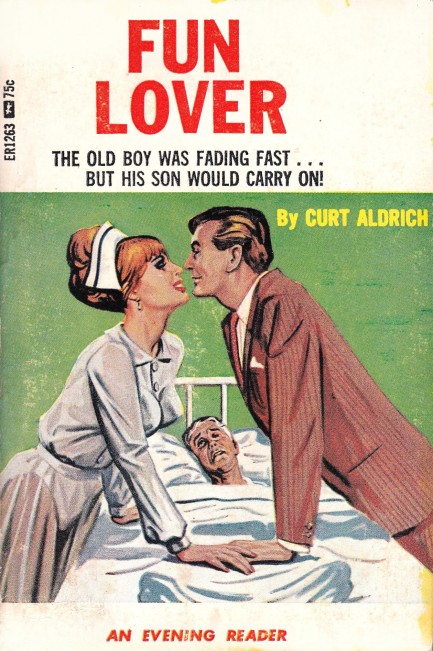
It's Greenleaf Classics again. Curt Aldrich's sleazer Fun Lover came in 1966 for the company's Evening Reader line with cover art from Tomas Cannizarro. And now for our personal Greenleaf favorites. Click here, here, here, here, and here.
 Don't stop till you get enough. 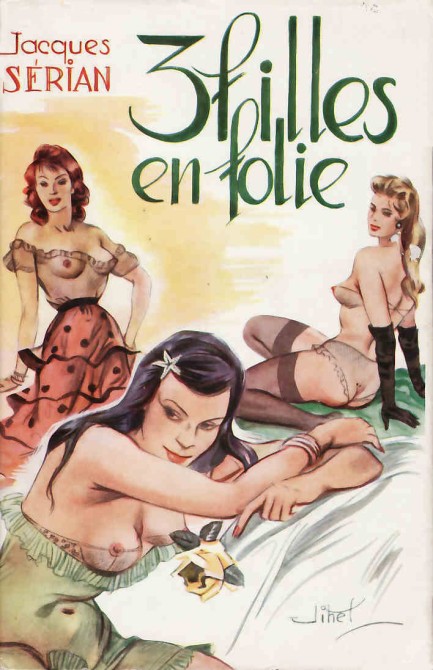 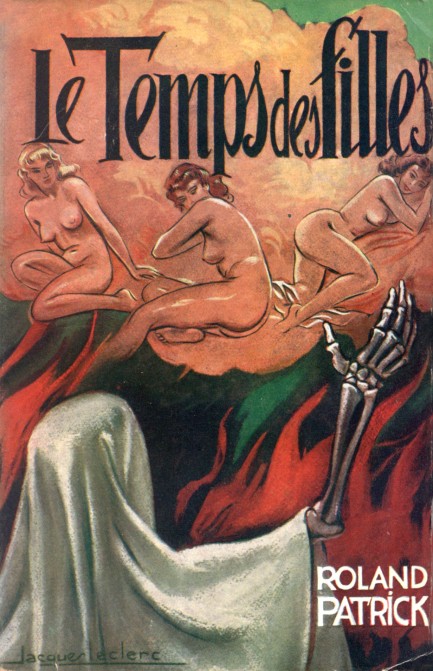
Above are a pair of covers by French illustrator Jacques Leclerq, aka Jihel, who by coincidence went in a similar direction on both, though it looks to us like the top book, 1957's 3 filles en folie, features his trio of filles in a somewhat paradisiacal setting, while the the bottom one, 1953's Le temps des filles, features them in a place that looks a lot like hell. We bet the trio in hell are more fun. See more from Jihel by clicking his keywords just below.
 Infancy, adulthood, and death in twenty-four years. 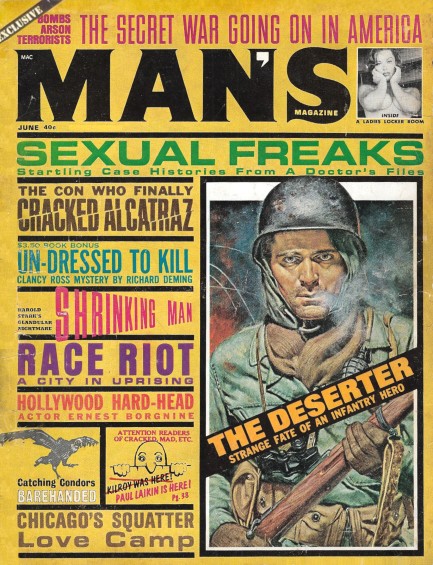
This issue of Man's Magazine hit newsstands this month in 1963 with Mel Crair cover art we suspect is cropped from a larger piece. In the past the magazine had featured paintings that occupied its entire front, but by this time it was experimenting with a tabloid look, giving more space to blocked text with sensational messaging, and reducing the dimensions of art acquired from Crair and others. More cover changes would come. From fully painted fronts, to the tabloid style you see here, it shifted to photo covers, which happened in 1969 and saw cheesecake and adventure imagery alternating, until the early ’70s when cheesecake took over and adventure was relegated entirely to the interior. Man's Magazine was by that point publishing nude and semi-nude women on all its covers. Other men's adventure magazines were doing the same.
This shift happened quickly, but had been in the wind for a long time. Private publications had crossed all red lines much earlier, though they hadn't been openly available. Producing and selling them was to risk prison. But it was understood that men wanted more eroticism, wanted it at high quality, and would buy it even if it wasn't behind the fig leaves of art and literature. However, art and literature were needed in above-ground publications because they helped avoid obscenity convictions. Otherwise, erotic content had no “redeeming qualities,” and legal troubles were guaranteed. Mainstream men's publications were largely articles, fiction, and cartoons for that reason—and to attract advertisers.
Man's Magazine had launched in 1952 and operated in reasonable health for at least fifteen years. But by the mid-1960s social repression and censorship were in retreat. Language was changing. Racier novels could be published without legal concerns, and more revealing cinematic content was possible. In the magazine realm, brands that foregrounded women's nudity more than previously were prospering. The erotic but coy Modern Man had launched in 1951. Playboy had arrived in 1954 and been willing to push the standards of what was possible. Penthouse arrived in the UK in 1965, in the U.S. in 1969, and began to show pubic hair. When Hustler arrived in 1974 the floodgates weren't just open, suddenly, but gaping.
Man's Magazine is a classic example of a publication that was swept away by all that change, but refused to go down without a fight. Its attempts to adapt failed and it folded in 1976. Interestingly, by the end, during the latter half of that year, it moved to personality covers. Cover stars included Richard M. Nixon, Muhammad Ali, and even Paul McCartney and Larry Csonka. We don't know what prompted that move—a final attempt to appear more highbrow, perhaps? We haven't bought any of those last gasp issues to seek clues, but nothing could help Man's Magazine retain market share in a landscape that featured publications with more nudity and gloss.
But it wasn't only explicitness and printing quality that pushed Man's Magazine and its ilk slowly off newsstands. With their tighter operating budgets when compared with Playboy and cohort, they generally had lower quality fiction, profiles, essays, and cartoons. By contrast Playboy would eventually interview some of the most important people in the world, and its fiction would feature the most acclaimed authors. Man's Magazine never had a prayer of keeping pace. But today's issue appeared before the decline. There's fiction from the well known Richard Deming, non-fiction by the respected Richard Hardwick, and many excellent illustrations. All of that and more are below. 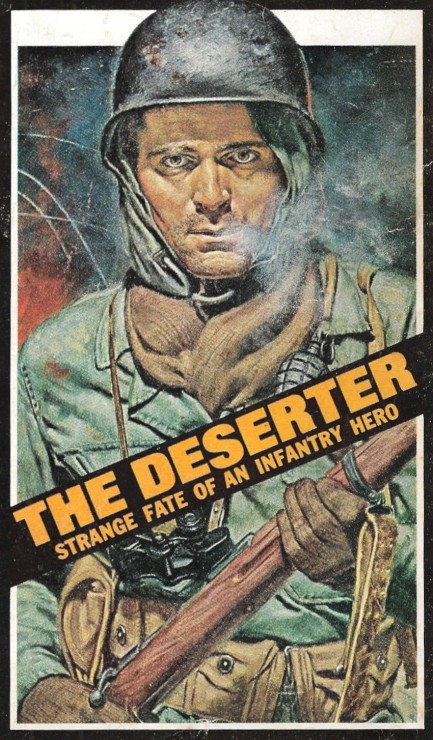 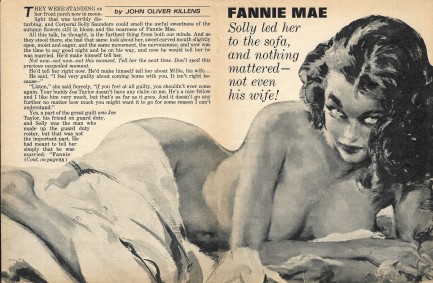 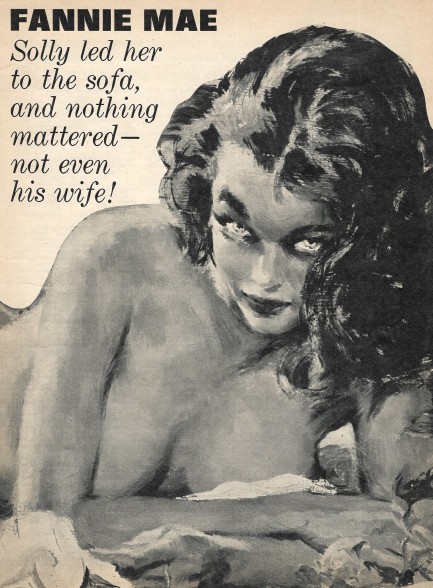 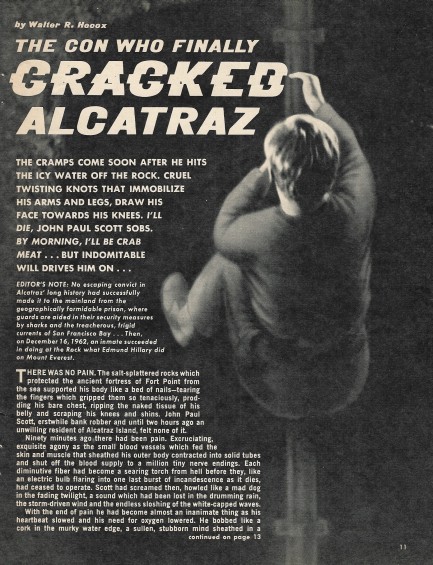 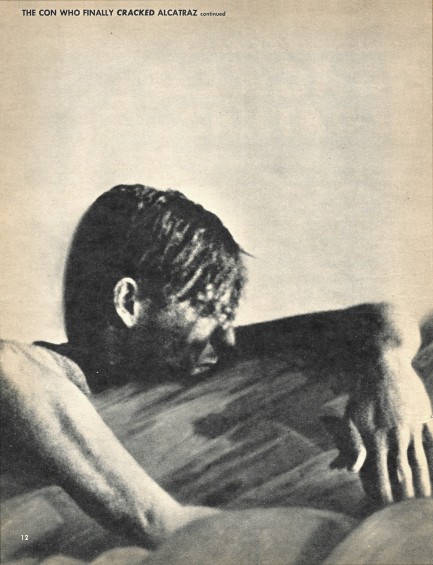 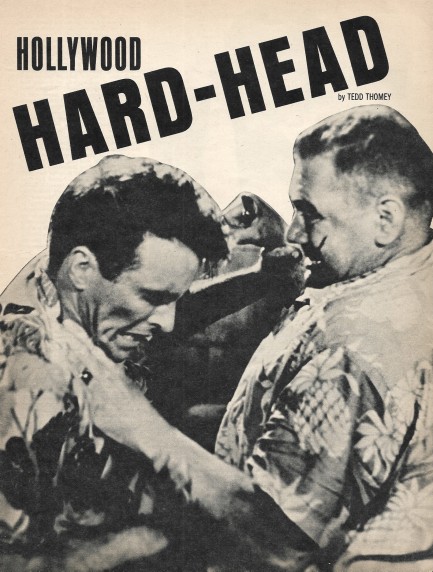 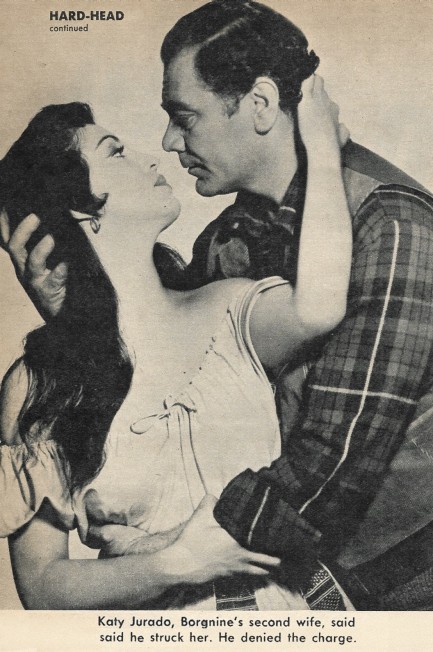 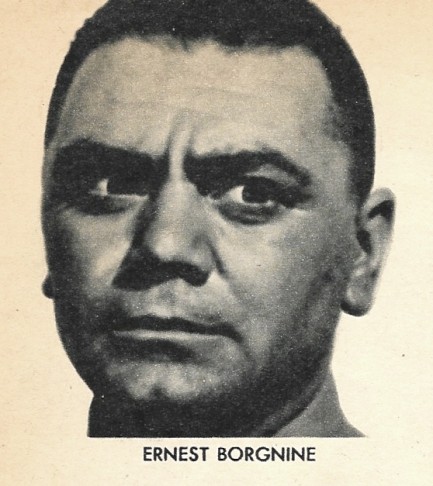  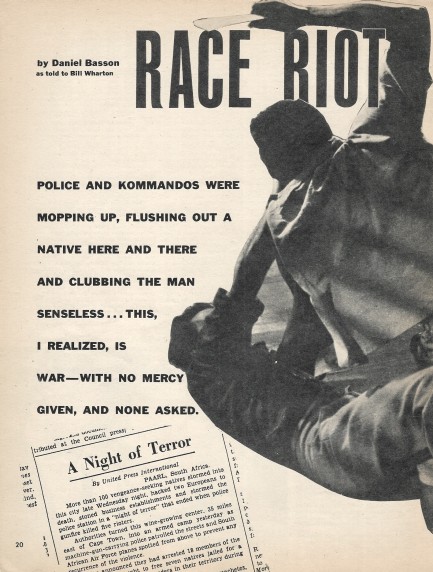 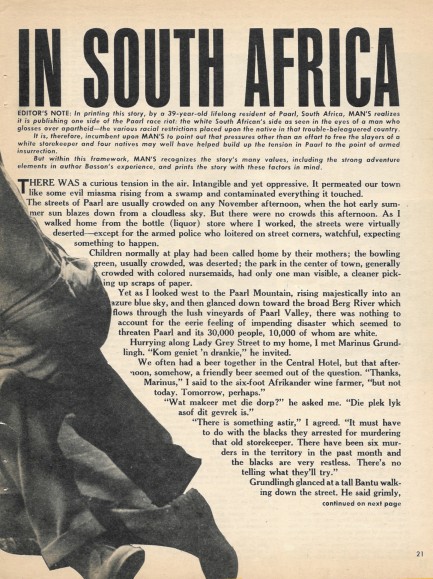 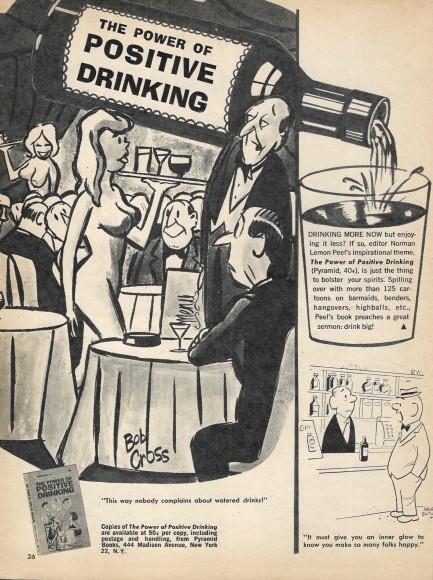  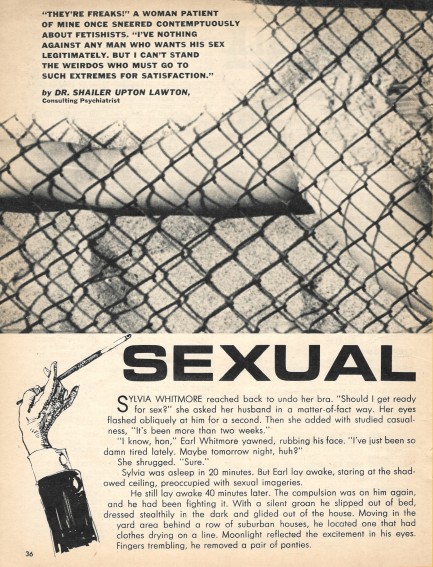 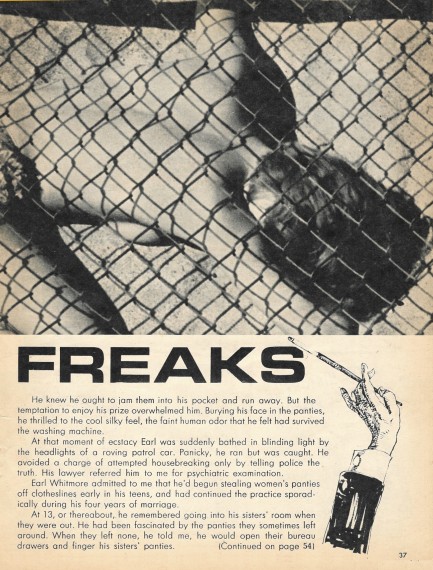 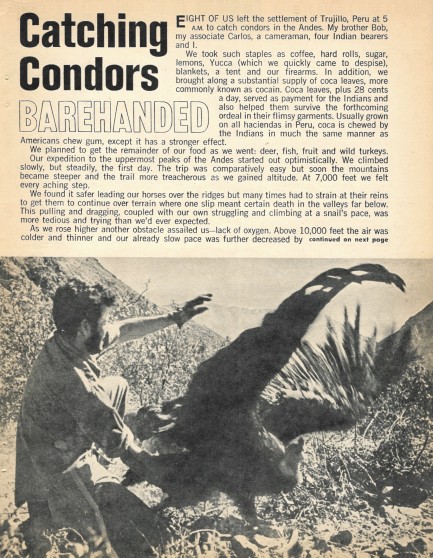 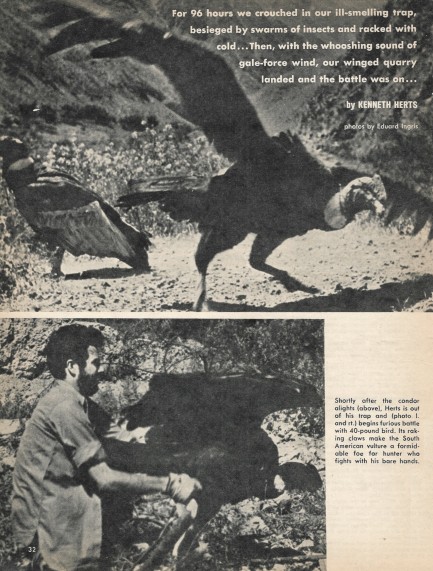 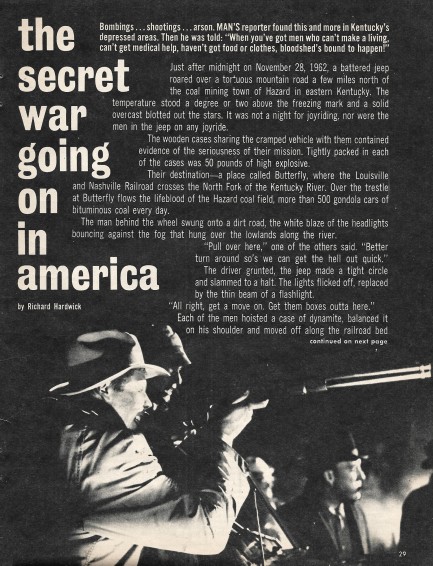  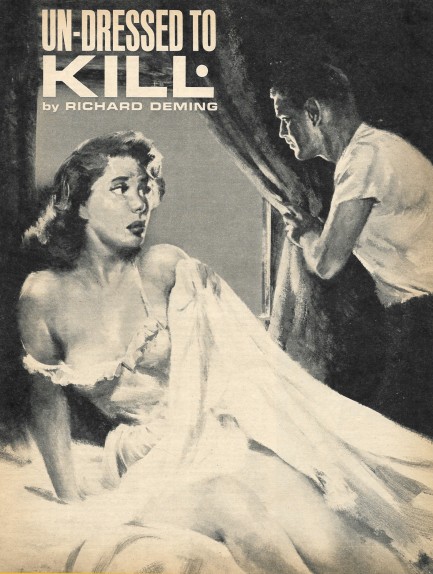 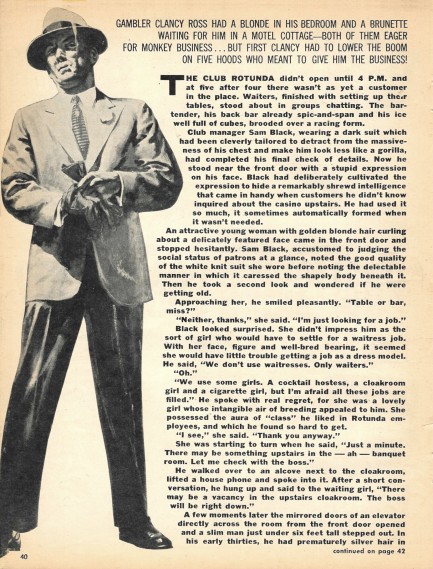  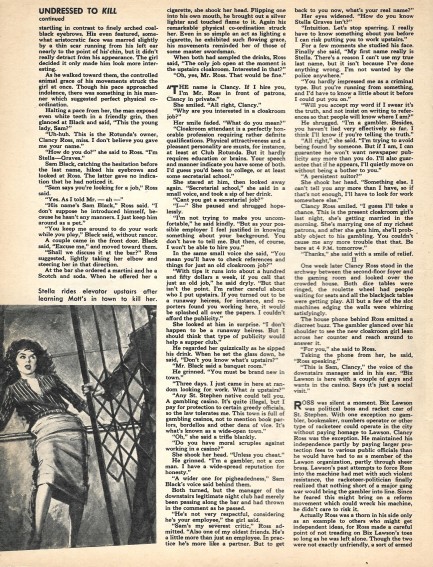 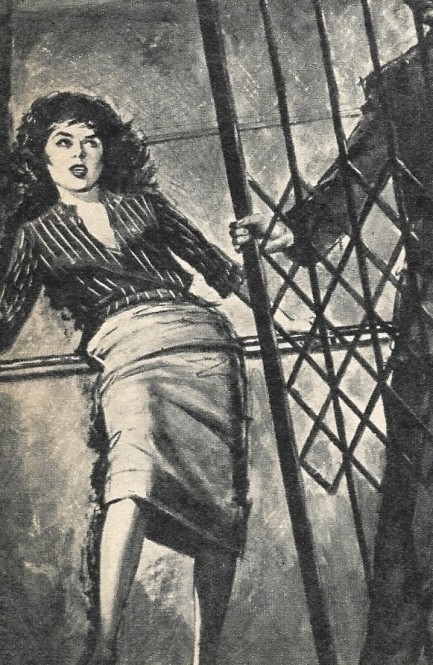 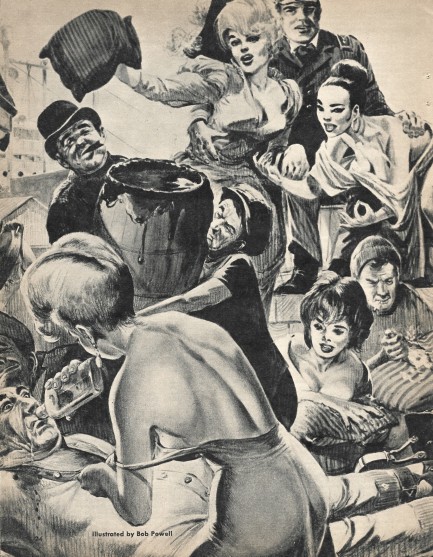 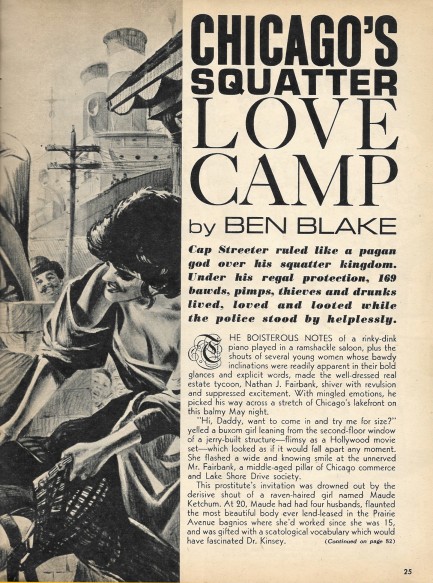
 Stray, little birds! Stray and be free! 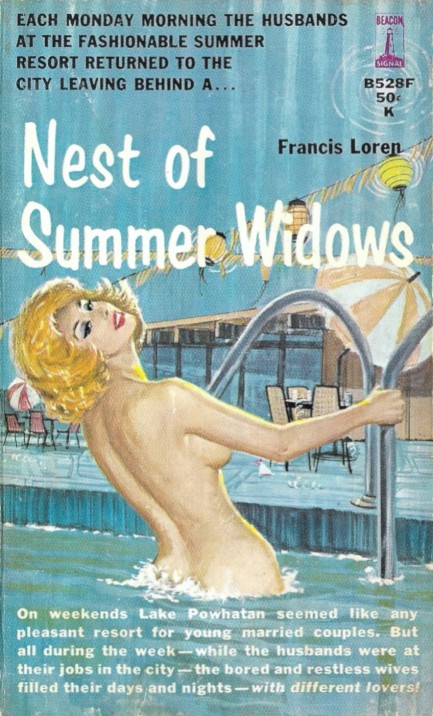
With a title like Nest of Summer Widows we absolutely had to read this 1962 effort from sleaze author Francis Loren, with its cool (uncredited) cover art, but guess what? There's no nest of widows. We took that to mean many widows. But there's only Ellen and Carla. The story is mainly about Ellen, whose husband spends each week away while she summers at Lake Powhatan. Let's stop for a sec. See, kids, “summering” is this thing people did—way before our time too, but we've read about it and seen it depicted in movies like The Seven Year Itch—where people left big cities for lake or beach regions and spent the hot months hanging around in swimsuits.
Ellen's husband is a lawyer, but isn't rich, which is the only measure of success she knows. She figures he doesn't lawyer hard enough. Since he comes to the lake only on the weekends, Ellen has plenty of idle time to get oopsied into bed by rich lake resident Tony Marsh. When Marsh later offers Ellen's hubby a lucrative job, lawyer boy hesitates because he thinks Marsh is a phony. The story finds Ellen torn between her husband and her sidepiece. Personally, we question a lawyer who's smart enough to pass the bar but not smart enough to know a rival's been dropping caseloads in his wife's inbox, but whatever.
We found a few aspects of the book interesting, but the chief curiosity is how most of what happens is a direct result of alcohol consumption, including the job offer. Those lake summerers really drank (scotch-sours and martinis, mainly). We guess the idle time made a body thirsty? It's a question we'd like to answer through firsthand experience one day. Cue the Pulp Intl. girlfriends: “You guys are thirsty 24/7. Why wouldn't you be thirsty idle?” It seems a fair point until you read the level of boozing in this book. But since they mention it— *off to the kitchen to build a quick cocktail*
Back now. And by the way, kids, that was a pro move, relationship-wise. Whenever your girl, wife, partner, mentions that you drink a lot, make a drink. It's a drinking game they won't know they're playing at first. It works best if you're flawless in every other aspect of your relationship. Hah—we only write stuff like that so they'll read it and roll their eyes at us. But returning to the book, Loren asks several questions that need resolution. What does a person do when their head says one thing but their sex organs say another? Is Ellen's husband a loser? Is Marsh a phony? Will summer ever end? Oh what tangled sleaze Loren weaves. 
 All you have to do is peel and enjoy. 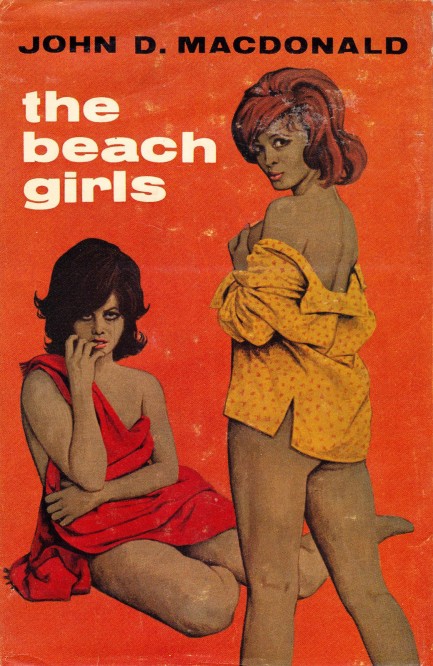
Above: another brilliant hardcover dust jacket from illustrator Barbara Walton, this time for John D. MacDonald's The Beach Girls, for British publisher Robert Hale, Ltd. The book was originally published in the U.S. in 1959, but the above edition came in 1968. To see more from Walton just click her keywords below, and to learn about the book click here.
 Get outta the frickin' way you lunatic! Are you out of your goddamned— Oh. I mean... need a lift? 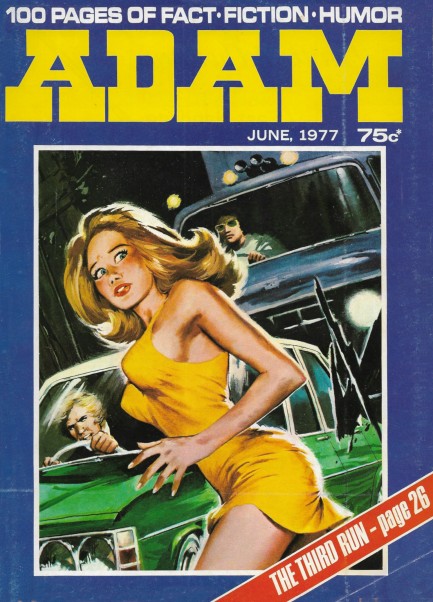
We're going back-to-back with Adam magazine. We posted one yesterday, but we have another because, despite the fact that this is the eighty-sixth issue we're sharing, we have a stack yay high we still need to get to. At this point we'll make the claim—without any proof whatsoever, but hey, that just means we're in step with the times—that we have more copies of Adam under our roof than any other place in the world. Prove us wrong. It's all the more impressive considering we don't live in Australia, where the magazine originates, and have needed to ship them wherever we were living at the time, currently (and permanently?) Spain.
Today's issue from this month in 1977 has the slightly more streamlined look the magazine moved toward as it approached its mid-1978 dissolution. The cover illustrates Jay Ruth's story “The Third Run.” We were eager to learn why the femme fatale crossed the road. It wasn't to get to the other side. She was trying to keep from being flattened, and not in the road as we assumed, but in a warehouse. In the story, she's part of a truck hijacking ring, and to her misfortune, she chooses as her newest victim an undercover operative posing as a truck driver. He'd been out there hoping to lure the hijackers, and on his third run he did. It's a pretty good story.
It wouldn't be an issue of Adam without models, and you get plenty here. By 1977 it was go full frontal to survive in the men's mag market or quit, and Adam quit—though resisting the shift to porn was probably only one of many considerations (moving to color and glossy page stock were probably others) However, though Adam never went all the way, one of the models wearing a bikini shows a bit of overflow bush and a treasure trail. Many times with later issues of Adam we're able to identify a model or two, but all the ones here are unknown to us. We're especially intrigued by the woman on the title page, with her short-shorts, superhero boots, and spectacular hair. Seems like, given the crucial masthead position, we should know who she is, but no such luck.
As a side note, we got an e-mail about our scans recently, another request for larger dimensions. We don't have the capability to do that easily, do to our website's design. We did offer a large scan once, a while back, for something special, but it was one image, not dozens. We couldn't even begin to do it for multiple images. Really, we're glad it's beyond the realm of practicality to change our scan sizes—for reasons already stated. But hey, at least we have a lot of them. Forty-plus panels worth, below. Please enjoy. Edit: the mystery woman is Minah Bird, a Nigerian born model and bit-part actress, whose onscreen credits include The Stud, Old Dracula and Four Dimensions of Greta.
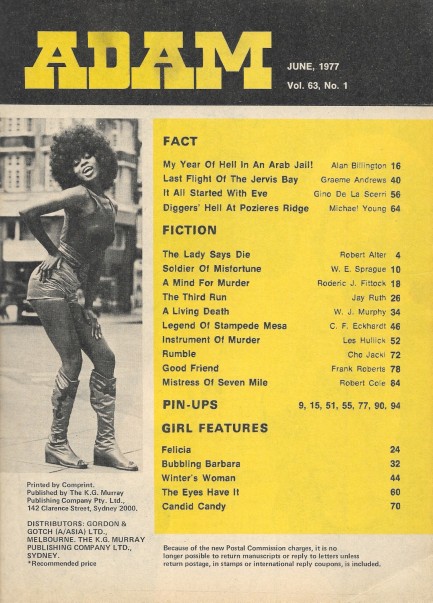 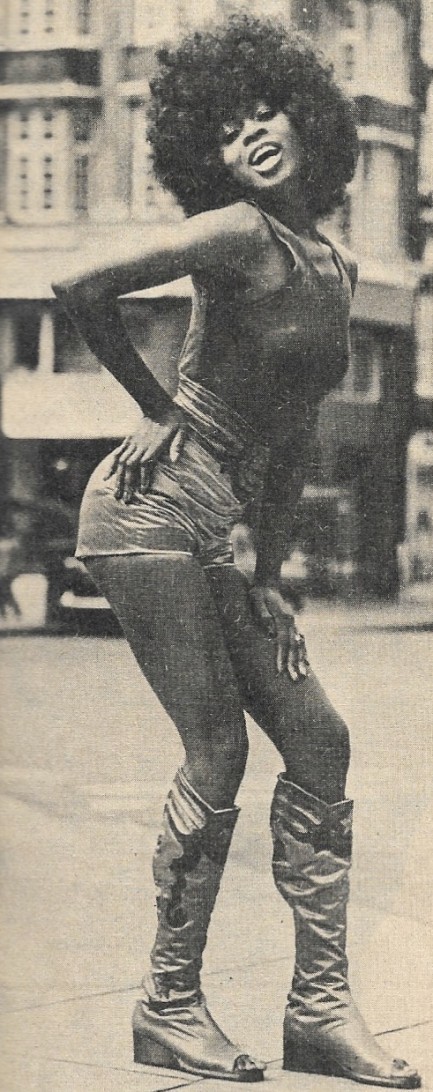  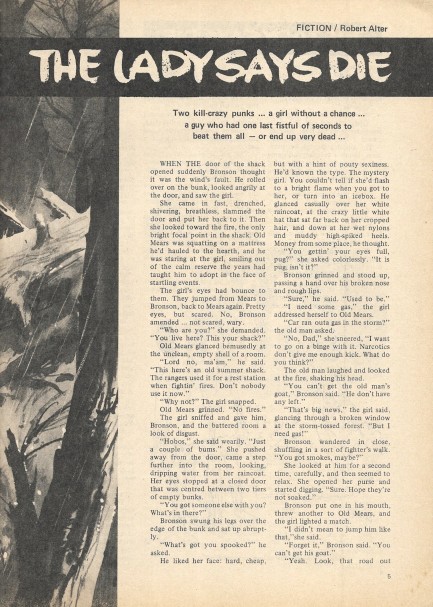     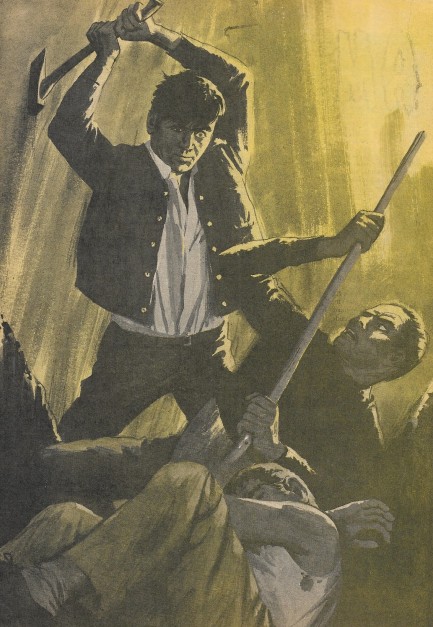 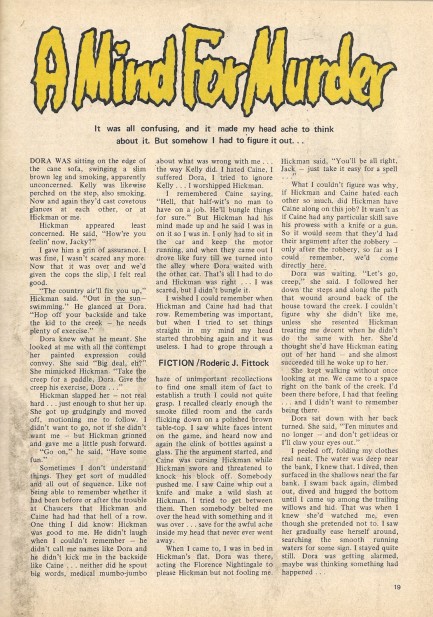 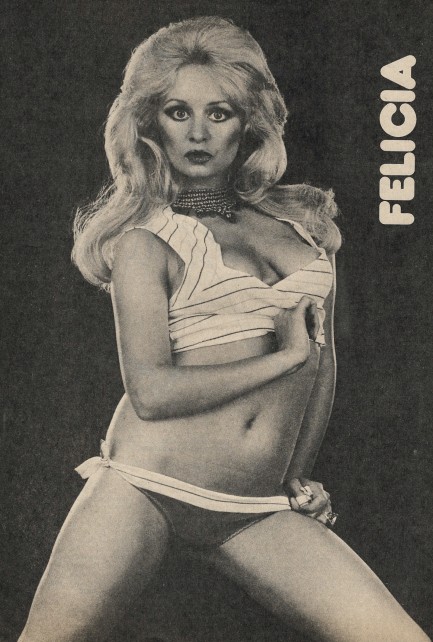  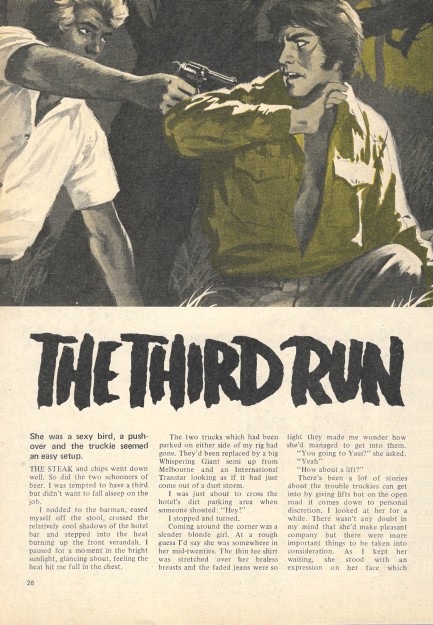 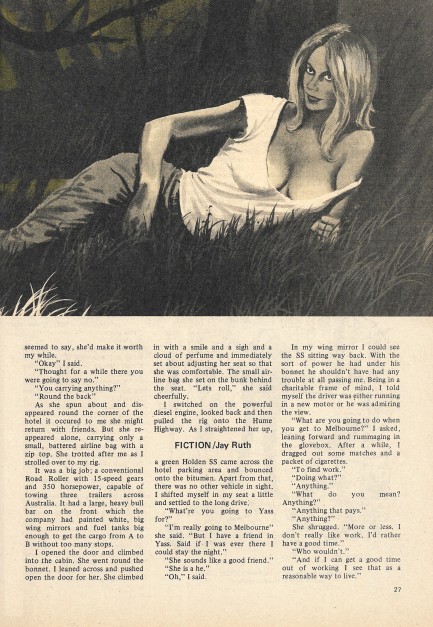 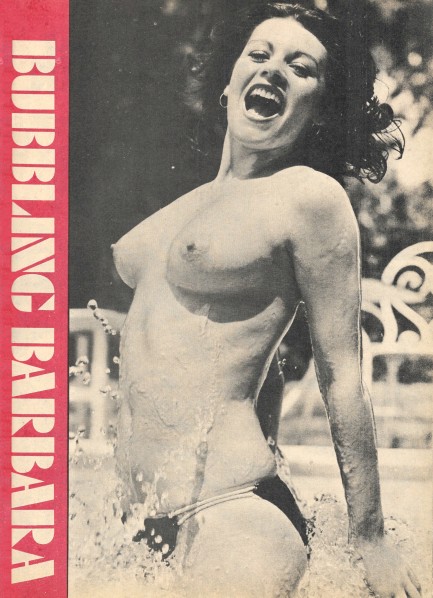   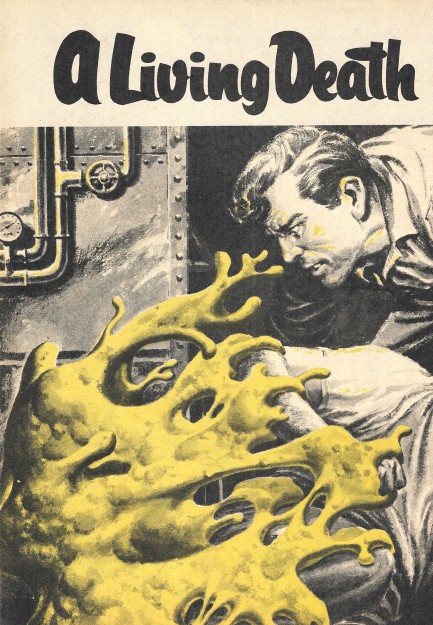 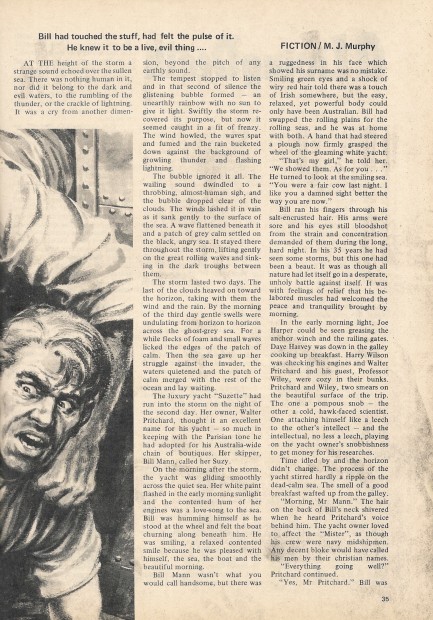    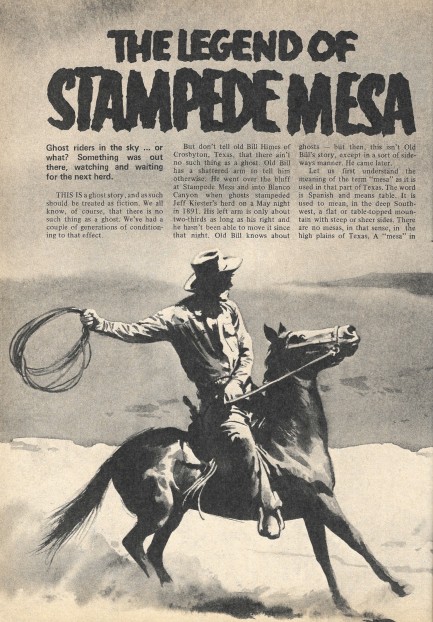 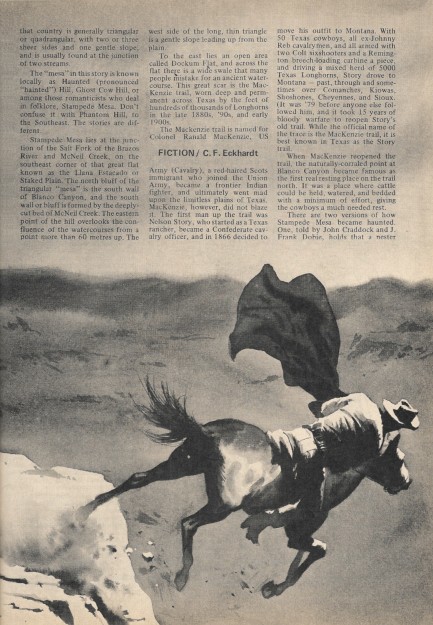  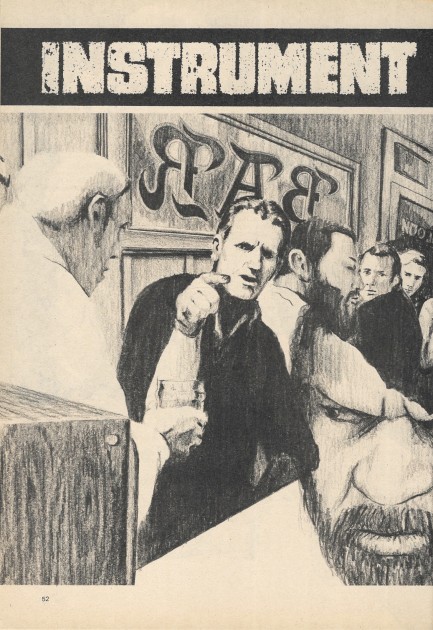 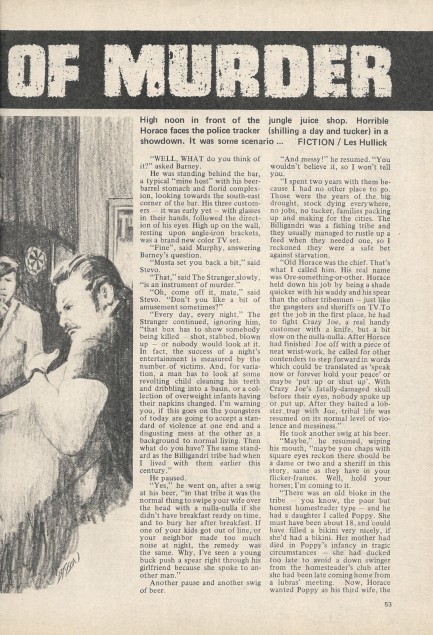  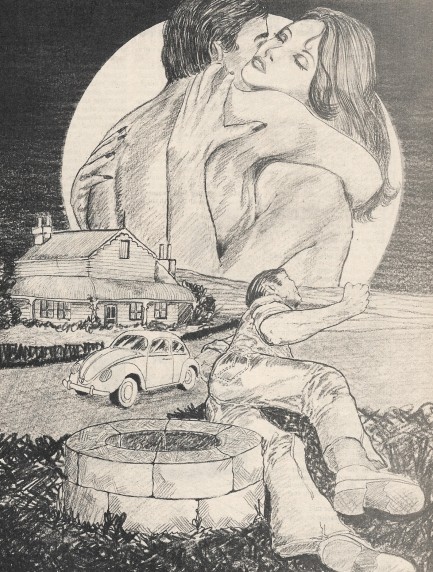       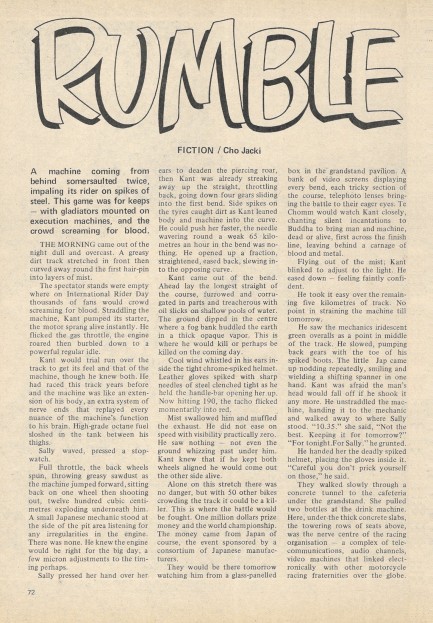 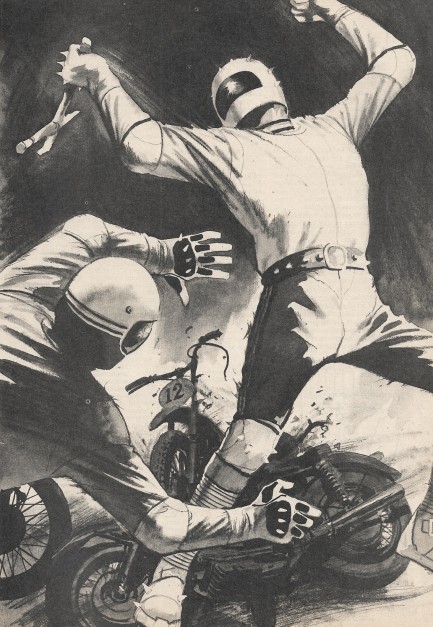  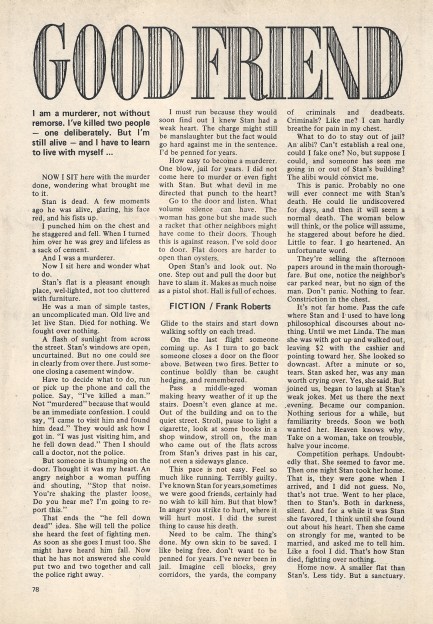 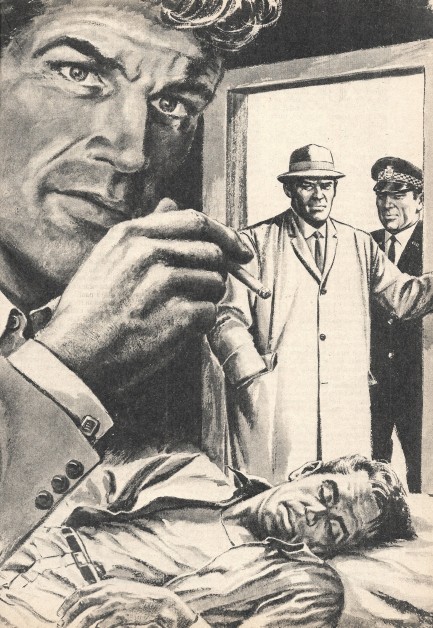 
 Get the right two people together and the heat can set the world on fire. 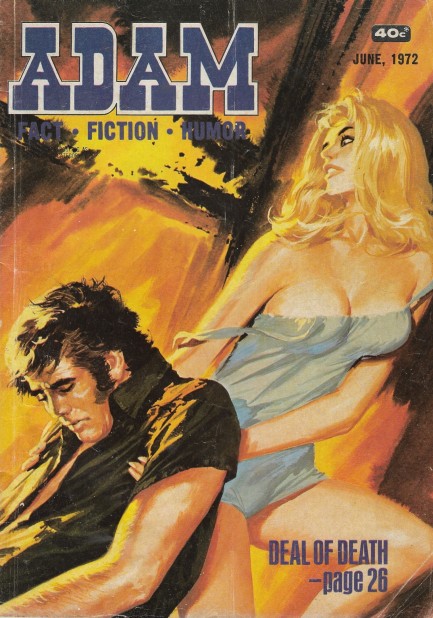  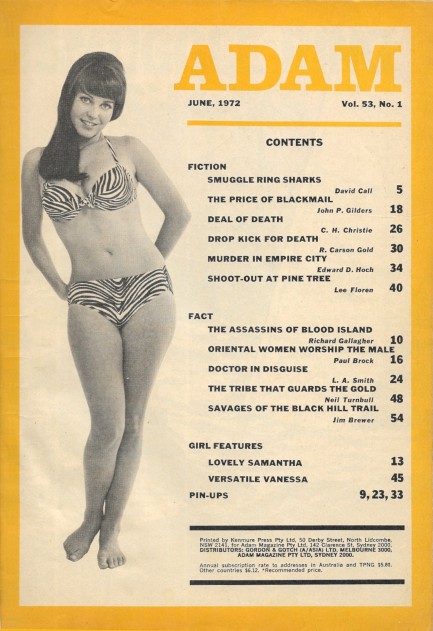 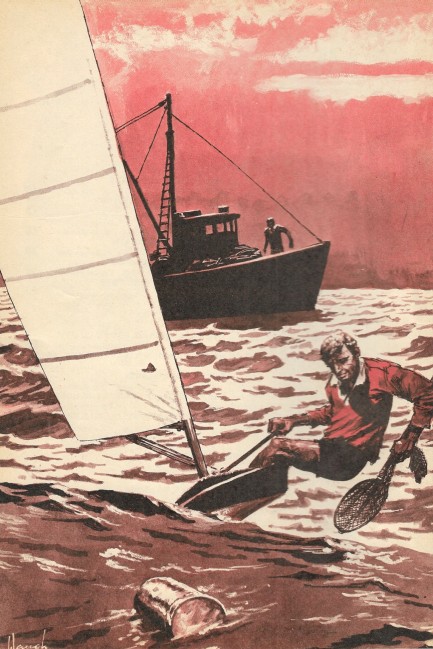 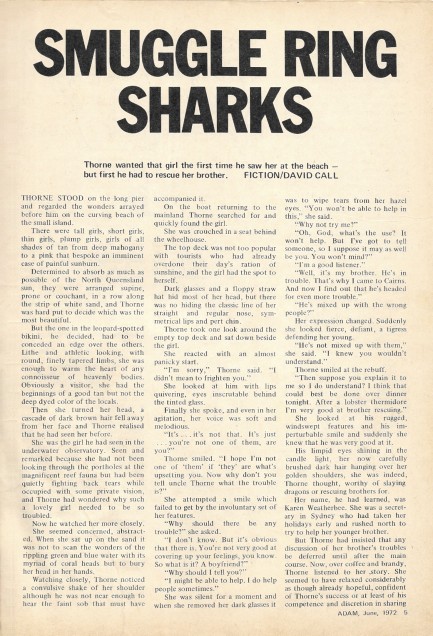  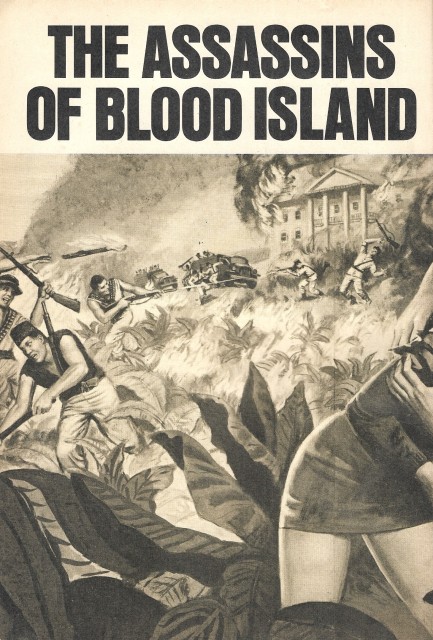        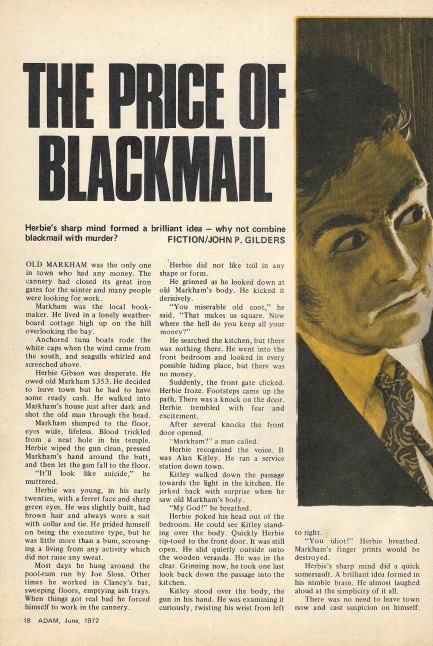 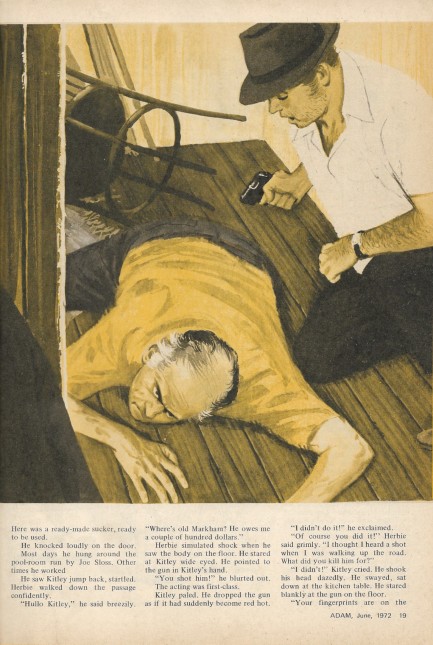  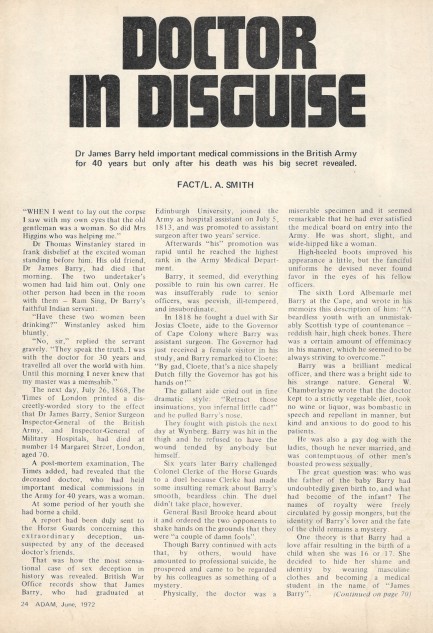 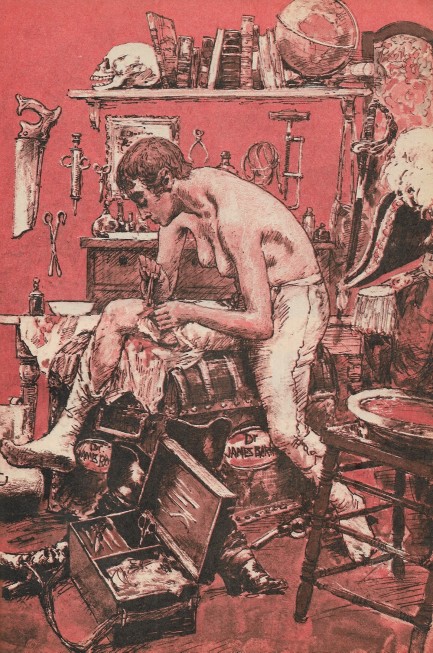 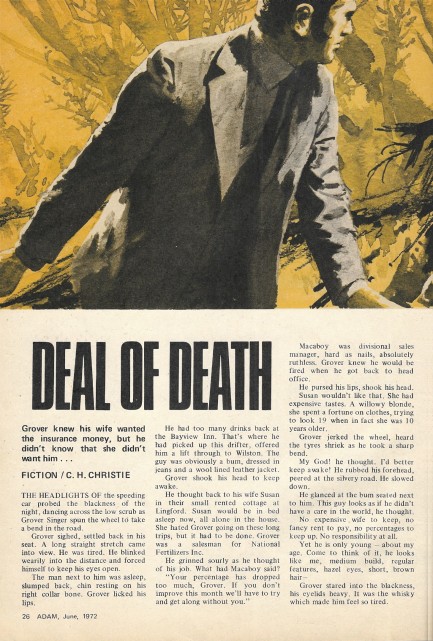 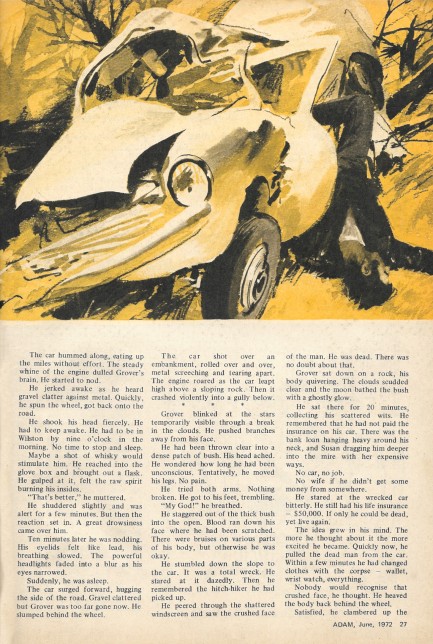   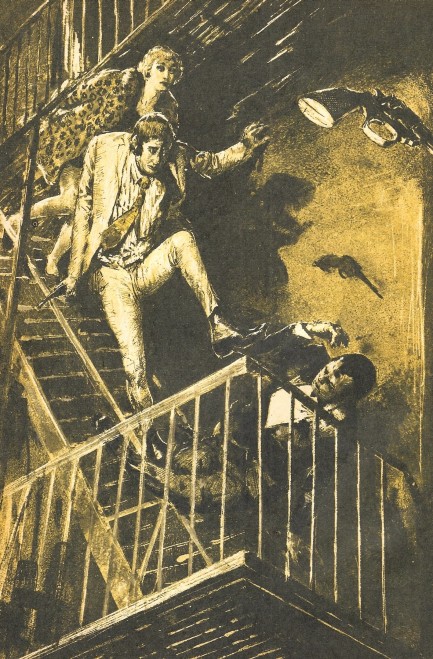      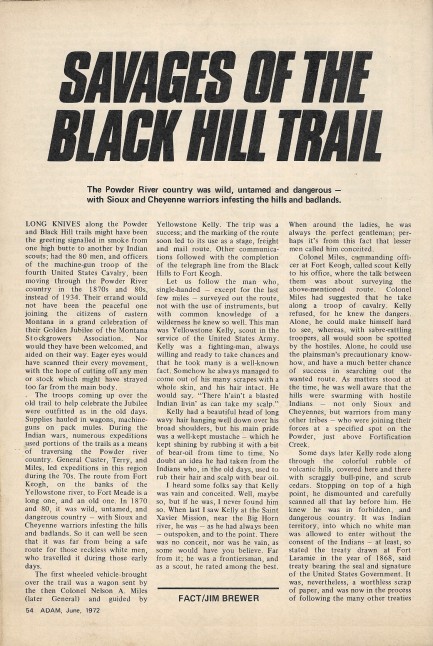 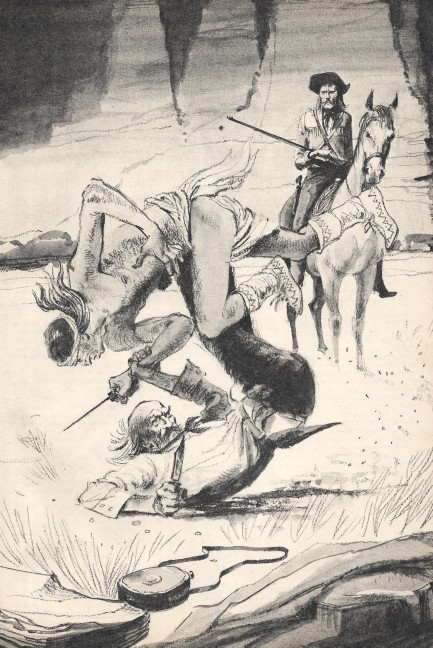 
Above: an issue of Adam magazine with another beautiful cover by Jack Waugh or Phil Belbin, illustrating C.H. Christie's story, “Deal of Death.” It's about a man named Grover Singer who's in debt and fakes his own death for $50,000 in insurance money (about $325,000 today). He does it by crashing his car with another man inside, but his wife knows right away the body isn't his. She doesn't tell the police, though, because she's been having an affair and recognizes the opportunity to run away with her lover and the cash. All that needs to happens is for someone to kill Grover for real. That's what lovers are for.
Also of note is the factual story “Doctor in Disguise.” The illustration give the disguise away. It's about a nineteenth century doctor named James Barry who practiced for forty years and upon death was revealed to be a woman. The long subterfuge involved everything from pretending to shave every morning in order to explain her smooth face to surviving a duel. In 2024, as women's rights remain under sustained attack, there's an opportunity built into this story for extensive commentary, but you know where we'd go, so pretend we went there and we'll let you get on with your Saturday. More from Adam soon.
 |  |
|
 |

The headlines that mattered yesteryear.
2003—Hope Dies
Film legend Bob Hope dies of pneumonia two months after celebrating his 100th birthday. 1945—Churchill Given the Sack
In spite of admiring Winston Churchill as a great wartime leader, Britons elect
Clement Attlee the nation's new prime minister in a sweeping victory for the Labour Party over the Conservatives. 1952—Evita Peron Dies
Eva Duarte de Peron, aka Evita, wife of the president of the Argentine Republic, dies from cancer at age 33. Evita had brought the working classes into a position of political power never witnessed before, but was hated by the nation's powerful military class. She is lain to rest in Milan, Italy in a secret grave under a nun's name, but is eventually returned to Argentina for reburial beside her husband in 1974. 1943—Mussolini Calls It Quits
Italian dictator Benito Mussolini steps down as head of the armed forces and the government. It soon becomes clear that Il Duce did not relinquish power voluntarily, but was forced to resign after former Fascist colleagues turned against him. He is later installed by Germany as leader of the Italian Social Republic in the north of the country, but is killed by partisans in 1945.
|

|
|

It's easy. We have an uploader that makes it a snap. Use it to submit your art, text, header, and subhead. Your post can be funny, serious, or anything in between, as long as it's vintage pulp. You'll get a byline and experience the fleeting pride of free authorship. We'll edit your post for typos, but the rest is up to you. Click here to give us your best shot.

|
|
































































































































































































